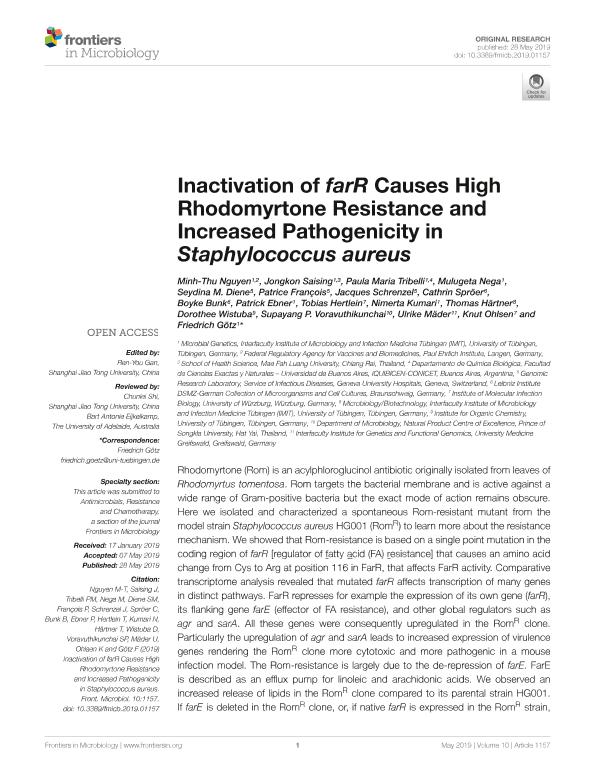Artículo
Inactivation of farR Causes High Rhodomyrtone Resistance and Increased Pathogenicity in Staphylococcus aureus
Nguyen, Minh-Thu; Saising, Jongkon; Tribelli, Paula Maria ; Nega, Mulugeta; Diene, Seydina M.; François, Patrice; Schrenzel, Jacques; Spröer, Cathrin; Bunk, Boyke; Ebner, Patrick; Hertlein, Tobias; Kumari, Nimerta; Härtner, Thomas; Wistuba, Dorothee; Voravuthikunchai, Supayang P.; Mäder, Ulrike; Ohlsen, Knut; Götz, Friedrich
; Nega, Mulugeta; Diene, Seydina M.; François, Patrice; Schrenzel, Jacques; Spröer, Cathrin; Bunk, Boyke; Ebner, Patrick; Hertlein, Tobias; Kumari, Nimerta; Härtner, Thomas; Wistuba, Dorothee; Voravuthikunchai, Supayang P.; Mäder, Ulrike; Ohlsen, Knut; Götz, Friedrich
 ; Nega, Mulugeta; Diene, Seydina M.; François, Patrice; Schrenzel, Jacques; Spröer, Cathrin; Bunk, Boyke; Ebner, Patrick; Hertlein, Tobias; Kumari, Nimerta; Härtner, Thomas; Wistuba, Dorothee; Voravuthikunchai, Supayang P.; Mäder, Ulrike; Ohlsen, Knut; Götz, Friedrich
; Nega, Mulugeta; Diene, Seydina M.; François, Patrice; Schrenzel, Jacques; Spröer, Cathrin; Bunk, Boyke; Ebner, Patrick; Hertlein, Tobias; Kumari, Nimerta; Härtner, Thomas; Wistuba, Dorothee; Voravuthikunchai, Supayang P.; Mäder, Ulrike; Ohlsen, Knut; Götz, Friedrich
Fecha de publicación:
05/2019
Editorial:
Frontiers Media S.A.
Revista:
Frontiers in Microbiology
ISSN:
1664-302X
Idioma:
Inglés
Tipo de recurso:
Artículo publicado
Clasificación temática:
Resumen
Rhodomyrtone (Rom) is an acylphloroglucinol antibiotic originally isolated from leaves of Rhodomyrtus tomentosa. Rom targets the bacterial membrane and is active against a wide range of Gram-positive bacteria but the exact mode of action remains obscure. Here we isolated and characterized a spontaneous Rom-resistant mutant from the model strain Staphylococcus aureus HG001 (RomR) to learn more about the resistance mechanism. We showed that Rom-resistance is based on a single point mutation in the coding region of farR [regulator of fatty acid (FA) resistance] that causes an amino acid change from Cys to Arg at position 116 in FarR, that affects FarR activity. Comparative transcriptome analysis revealed that mutated farR affects transcription of many genes in distinct pathways. FarR represses for example the expression of its own gene (farR), its flanking gene farE (effector of FA resistance), and other global regulators such as agr and sarA. All these genes were consequently upregulated in the RomR clone. Particularly the upregulation of agr and sarA leads to increased expression of virulence genes rendering the RomR clone more cytotoxic and more pathogenic in a mouse infection model. The Rom-resistance is largely due to the de-repression of farE. FarE is described as an efflux pump for linoleic and arachidonic acids. We observed an increased release of lipids in the RomR clone compared to its parental strain HG001. If farE is deleted in the RomR clone, or, if native farR is expressed in the RomR strain, the corresponding strains become hypersensitive to Rom. Overall, we show here that the high Rom-resistance is mediated by overexpression of farE in the RomR clone, that FarR is an important regulator, and that the point mutation in farR (RomR clone) makes the clone hyper-virulent.
Archivos asociados
Licencia
Identificadores
Colecciones
Articulos(IQUIBICEN)
Articulos de INSTITUTO DE QUIMICA BIOLOGICA DE LA FACULTAD DE CS. EXACTAS Y NATURALES
Articulos de INSTITUTO DE QUIMICA BIOLOGICA DE LA FACULTAD DE CS. EXACTAS Y NATURALES
Citación
Nguyen, Minh-Thu; Saising, Jongkon; Tribelli, Paula Maria; Nega, Mulugeta; Diene, Seydina M.; et al.; Inactivation of farR Causes High Rhodomyrtone Resistance and Increased Pathogenicity in Staphylococcus aureus; Frontiers Media S.A.; Frontiers in Microbiology; 10; MAY; 5-2019; 1-14
Compartir
Altmétricas



